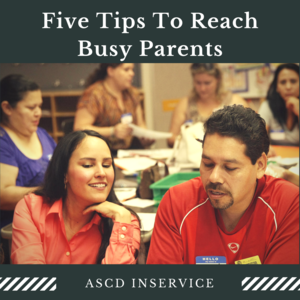The most common complaint that educators have when it comes to communicating with families is that parents often ignore information supplied by educators, especially if it provides explanations of learning activities and goals. There is a lot of truth to this. In the world where our attention is constantly being pulled into multiple directions, competition for people’s time is fierce. In order to dedicate any portion of it to reading for understanding, rather than quickly skipping over information, parents have to find it personally relevant and important to them.
While there is no guarantee that all parents and community members can be reached at all times, there is a number of factors that might help with establishing relevance and overcoming the “getting through” barrier.
‘Presence’ Factor
A lot can be said about face-to-face communication. This is the time when educators have undivided attention of their audience. There is no better opportunity to establish collaboration and introduce the rationale behind classroom practices than when parents are there to listen for understanding. This is true for individual classroom meetings, grade-level gatherings, or school-wide events. w.
Through conversations, teachers and administrators can determine what topics are particularly of an interest to parents and supply this information through social media or emails. It’s a good time to ask parents to stay turned to education-related social media posts (with an immediate request to follow certain Facebook pages and Twitter accounts). Even a simple request from a teacher to pay attention to emails or what is posted will substantially increase chances of getting through.
‘Timing’ Factor
There seems to always be hot issues in education that generate interest and stir a lot of opinionated discussions. Schools can capitalize on these topics in order to provide more in-depth information and create awareness about educational trends. One of such topics, for example, is state standardized testing, especially around the time this testing is implemented at schools. Any insights about alternative assessments, such as project-based learning and learners’ portfolios, for example, could create a lot of interest in a community. It could also be the right time to throw around ideas of what is needed for such learning or assessments to take place, including needs for technology or additional infrastructure.
‘Story’ Factor
One of the techniques that can be especially useful in education is telling stories and connecting them to big learning whys. Stories are tools of power; they can persuade and move people to action. Jennifer Aaker (Harnessing the Power of Stories, n.d.), a Professor of Marketing at Stanford Graduate School of Business, shares that stories are up to 22 times more memorable than facts or figures alone. They are effective tools to advocate for ideas, especially when facts and figures are also weaved into this story. Anyone, from a teacher to a district leader, can tell stories about children and their learning in connection to a larger purpose.
‘Student Agency’ Factor
If something is personally important and relevant to students, they will “sell” it to their parents, or at least make sure that information reaches its destination. When students are in charge of something, they want to know how what they do impacts others, so they are more likely to keep on bringing this to their parents’ attention. Teachers frequently ask students to get their parents’ signatures on a test or any other activity of which they want to make sure parents are aware. Often, some credit is given for delivering this signature. While, of course, it is rather difficult to create awareness based on signatures, if there is something conceptually important to the learning process, students can be asked to make sure that their parents read the information.
There are many ways how students can become agents of awareness within their own home and communities. It is always important to remember that they have the power to get attention from those close to them.
‘Here and Now’ Factor
Email communication is by far the most preferred way for educators to share some instruction-related information. Yet, when it comes to creating educational awareness, it might not be as effective as schools want it to be. When a class is covering multiple ways of solving a problem in math or doing a particular project activity that parents may find unclear, for example, a lot of diligent educators reserve to sending long email messages to families with explanations of the what and the how (and may be even the why). Later, however, they find out that the majority of the parents have never read it. Time is wasted; frustration is high. Why would this be the case?
One frequent real-life situation is that working, education-removed parents check their emails on a go, often driving from work, when there is no real capacity for understanding anything lengthy or complex. At home, there are extracurricular activities, dinner, and physical exhaustion. The only time that parents might have left in their day would be spent on looking over that very classwork or homework mentioned in the email. By that time, the computer is in the other room, the smart phone needs charging, and there is no desire to get up and read a long e-mail.
One solution is to pair important student work with a sheet providing a brief, bulleted explanation of what parents see in their child’s work and the benefits of this project or learning. After the first look at a worksheet, parents are often puzzled and, therefore, motivated to find out more. Then, the attached second page supplies explanations and makes references to what can immediately be found in the child’s work.
The good news is that schools have a great “competitive advantage”—children. Most parents care about their children. Teachers or school administrators can capitalize on this relevance to create awareness of new educational ideas and the direction schools are taking.








